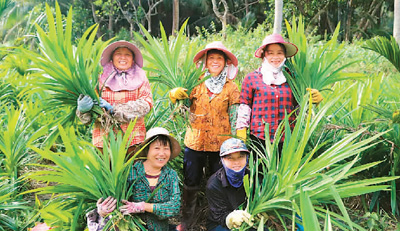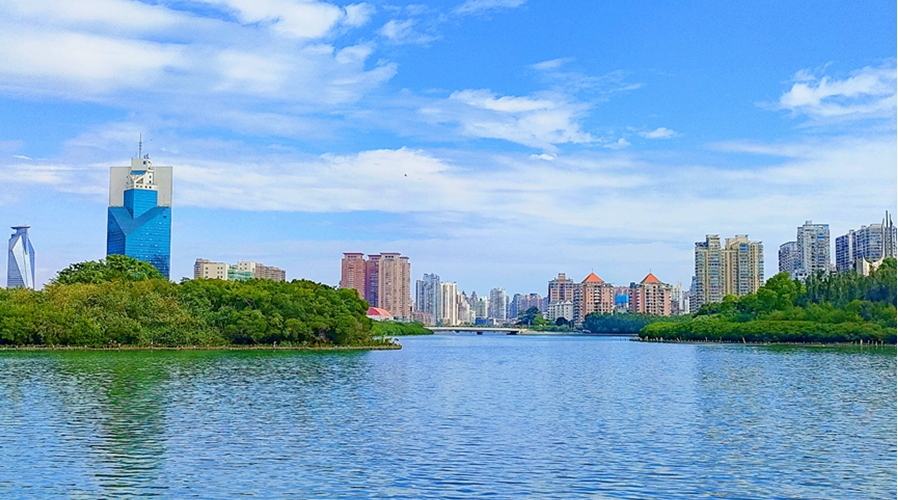Flourishing pandan industry brings prosperity to village in China's Hainan
The thriving development of the pandan industry has generated wealth for people in Jiachang village, Zhongxing township, Wenchang city, south China's Hainan Province.
Four years ago, the village began large-scale cultivation of pandan, a tropical fragrant plant. Overseas Chinese from Southeast Asia brought pandan seedlings back to Hainan over 100 years ago. The plant has now become an indispensable spice in the culinary world of the province.

Villagers show pandan leaves they harvested in Jiachang village, Zhongxing township, Wenchang city, south China's Hainan Province. (Photo courtesy of the Zhongxing pandan farm)
In 2020, Lin Mingtian, a native of Jiachang village who had worked outside his hometown for 25 years, invested over 1 million yuan (about $138,347) establishing a pandan farm in the village, helping its residents develop the pandan industry. Meanwhile, the villagers' committee set up a collective economic cooperative to encourage villagers to expand the planting area of pandan.
Hainan's climate and soil are highly suitable for growing pandan, Lin said, adding that the plant can be harvested every two months for 10 to 15 years.
The village has also collaborated with research institutes like the Chinese Academy of Tropical Agricultural Sciences (CATAS), with experts providing technical guidance for villagers.
The total cultivation area of pandan plants in Jiachang village has surpassed 2,000 mu (about 133.33 hectares), with 1 mu of land able to accommodate 1,000 pandan plants.

Photo shows cakes made with pandan leaves. (People's Daily Overseas Edition/Jia Pingfan)
Pandan grows well under trees, according to Fu Datao, a villager in Jiachang. Fu plants over 20 mu of pandan and is a member of the village's collective economic cooperative.
"We don't have to worry about sales," Fu said, explaining that several years ago the villagers' committee signed a contract with a company that has business operations in the village to purchase fresh pandan leaves at a price that is not lower than the agreed reserve price of 5.2 yuan per kilogram.
The villagers' committee arranges for personnel to carry out routine management of the plant such as fertilizing, watering and weeding. It also provides villagers with a 15-percent year-end dividend based on the year's production value.
In terms of factory rental and revenue from the pandan industry, the annual income of the village's collective economic cooperative exceeds 1.05 million yuan. The villagers' annual income generated per mu of land for underwood planting of pandan remains stable above 3,000 yuan. The per capita income of villagers in Jiachang reached 23,100 yuan in 2023.
Wang Xin, e-commerce director of the pandan farm, said that several e-commerce stores in the village have seen a growth in sales recently.
Wang, from northeast China's Heilongjiang Province, has been engaged in the e-commerce industry for several years in Hangzhou, capital of east China's Zhejiang Province.
When Wang and her family members traveled to Hainan in 2020, she spotted a niche in the market as there were few online stores selling pandan leaves. She then conducted research and contacted e-commerce platforms and logistics companies. During this process, she happened to acquaint herself with Lin. They hit it off right away and decided to establish an e-commerce team for the pandan farm.
"As the market recognition and popularity of pandan continued to improve, the plant gradually enjoyed sales volume growth, We sell an average of over 2,000 kilograms of the plant every day, of which online sales average about 250 kilograms per day," Wang said.
The pandan farm has now trained five experienced e-commerce livestreamers. "More and more villagers are starting to learn e-commerce skills. In addition to selling pandan, many villagers are also selling their agricultural products like coconuts, peppers, pineapples, and wax apples via e-commerce platforms and livestreaming sessions," Wang added.

Students show pandan seedlings they planted in Jiachang village, Zhongxing township, Wenchang city, south China's Hainan Province. (Photo courtesy of the Zhongxing pandan farm)
With the help of research institutes including CATAS, the pandan farm has also created a public brand and developed pandan-related products, said Liu Yilei, general manager of the pandan farm.
"The thriving development of the pandan industry has brought benefits to villagers. Many villagers who used to work outside have returned to their hometown," Wang said, adding that many young people have joined the farm after graduating from college.
The pandan farm has also become an educational tour base for some primary and middle schools in Hainan, a popular rural tourism destination, a provincial demonstration base of the underwood economy, and a production, study and research base of the Spice and Beverage Research Institute of the CATAS.
According to preliminary statistics, more than 30,000 visitors and teenagers came to Jiachang village for sightseeing and study trips in 2023.
Photos
Related Stories
- Exploring Hainan's intangible cultural heritage
- Feature: A sports collector's journey to opening a museum in China's Hainan
- Qionghai's villages in Hainan showcase rural revitalization with global appeal
- Construction of Linglong One in Hainan goes moothly
- Demonstration zone in Hainan shows China's green practices
- Village in Hainan explores new developing model to advance rural revitalization
Copyright © 2024 People's Daily Online. All Rights Reserved.









